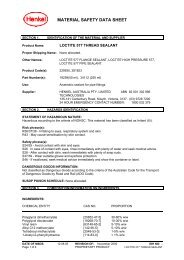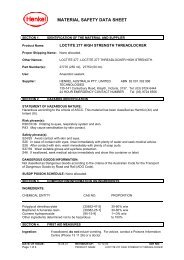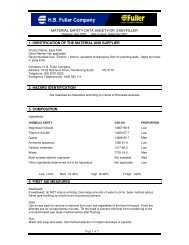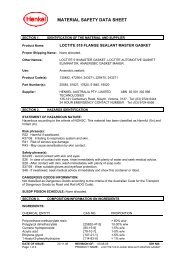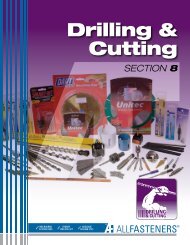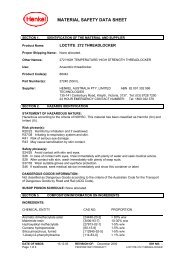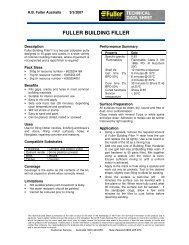Bostik 9913 Solvent - All Fasteners
Bostik 9913 Solvent - All Fasteners
Bostik 9913 Solvent - All Fasteners
You also want an ePaper? Increase the reach of your titles
YUMPU automatically turns print PDFs into web optimized ePapers that Google loves.
Material Safety Data SheetHazardous Substance, Dangerous Goods1. MATERIAL AND SUPPLY COMPANY IDENTIFICATIONProduct name: <strong>Bostik</strong> <strong>9913</strong> <strong>Solvent</strong>Synonyms:Mancode<strong>Bostik</strong> <strong>9913</strong> <strong>Solvent</strong>, 4 Litres 045454<strong>Bostik</strong> <strong>9913</strong> <strong>Solvent</strong>, 20 Litres 045462Recommended use: A thinner or cleaner for polychloroprene and natural rubber adhesives.Supplier: <strong>Bostik</strong> Australia Pty LtdABN: 79 003 893 838Street Address: 51-71 High StreetThomastown VIC 3074AustraliaTelephone: +613 9279-9333Facsimile: +613 9279-9342Emergency telephone number: 1800 033 1112. HAZARDS IDENTIFICATIONThis material is hazardous according to health criteria of NOHSC Australia.Hazard Category:Xn HarmfulXi IrritantRisk Phrase(s):R20: Harmful by inhalation.R38: Irritating to skin.R65: Harmful: May cause lung damage if swallowed.R67: Vapours may cause drowsiness and dizziness.Safety Phrase(s)S23: Do not breathe vapour.S24/25:Avoid contact with skin and eyes.S36/37/39: Wear suitable protective clothing, gloves and eye/face protection.S38: In case of insufficient ventilation, wear suitable respiratory equipment.Classified as Dangerous Goods by the criteria of the Australian Dangerous Goods Code (ADG Code) forTransport by Road and Rail.Class: 3 Flammable LiquidPoisons Schedule (Aust): S5This material is a Scheduled Poison S5 and must be stored, maintained and used in accordance with therelevant regulations.Product name: <strong>Bostik</strong> <strong>9913</strong> <strong>Solvent</strong>Issued: 28 April 2005 Version: 1.0 Page: 1 of 8Substance Key: BOS0021602
Material Safety Data Sheet3. COMPOSITION INFORMATIONCHEMICAL ENTITY CAS NO. PROPORTIONNaphtha (petroleum), hydrotreated light 64742-49-0 30-60%Toluene 108-88-3 30-60%Acetone 67-64-1 1-10%________100%4. FIRST AID MEASURESIf poisoning occurs, contact a doctor or Poisons Information Centre (Phone Australia 131 126, New Zealand0800 764 766).Inhalation: Remove victim from exposure - avoid becoming a casualty. Remove contaminated clothing andloosen remaining clothing. <strong>All</strong>ow patient to assume most comfortable position and keep warm. Keep at restuntil fully recovered. If breathing laboured and patient cyanotic (blue), ensure airways are clear and have aqualified person give oxygen through a facemask. If breathing has stopped apply artificial respiration atonce. In the event of cardiac arrest, apply external cardiac massage. Seek immediate medical advice.Skin contact: For gross contamination, immediately drench with water and remove clothing. Continue toflush skin and hair with plenty of water (and soap if material is insoluble). For skin burns, cover with a clean,dry dressing until medical help is available. If blistering occurs, do NOT break blisters. If swelling, redness,blistering, or irritation occurs seek medical assistance.Eye contact: If in eyes wash out immediately with water. In all cases of eye contamination it is a sensibleprecaution to seek medical advice.Ingestion: Immediately rinse mouth with water. If swallowed, do NOT induce vomiting. Give a glass ofwater to drink. Never give anything by the mouth to an unconscious patient. If vomiting occurs give furtherwater. Seek immediate medical advice.Notes to physician: Treat symptomatically. Effects may be delayed. Delayed pulmonary oedema mayresult.5. FIRE-FIGHTING MEASURESSpecific hazards: Flammable liquid. May form flammable vapour mixtures with air. Flameproof equipmentnecessary in area where this chemical is being used. Nearby equipment must be earthed. Electricalrequirements for work area should be assessed according to AS3000.Vapour may travel a considerabledistance to source of ignition and flash back. Avoid all ignition sources. <strong>All</strong> potential sources of ignition(open flames, pilot lights, furnaces, spark producing switches and electrical equipment etc) must beeliminated both in and near the work area. Do NOT smoke.Fire fighting further advice: Heating can cause expansion or decomposition leading to violent rupture ofcontainers. If safe to do so, remove containers from path of fire. Keep containers cool with water spray. Onburning may emit toxic fumes. Fire fighters to wear self-contained breathing apparatus and suitableprotective clothing if risk of exposure to vapour or products of combustion.Hazchem Code: 3[Y]E.Product name: <strong>Bostik</strong> <strong>9913</strong> <strong>Solvent</strong>Issued: 28 April 2005 Version: 1.0 Page: 2 of 8Substance Key: BOS0021602
Material Safety Data SheetSuitable extinguishing media: If material is involved in a fire use foam, dry agent (carbon dioxide, drychemical powder).6. ACCIDENTAL RELEASE MEASURESSMALL SPILLSWear protective equipment to prevent skin and eye contamination. Avoid inhalation of vapours. Wipe upwith absorbent (clean rag or paper towels). Collect and seal in properly labelled containers or drums fordisposal.LARGE SPILLSShut off all possible sources of ignition. Clear area of all unprotected personnel. Slippery when spilt. Avoidaccidents, clean up immediately. Wear protective equipment to prevent skin and eye contamination and theinhalation of vapours. Work up wind or increase ventilation. Contain - prevent run off into drains andwaterways. Use absorbent (soil, sand or other inert material). Collect and seal in properly labelledcontainers or drums for disposal. If contamination of sewers or waterways has occurred advise localemergency services.Dangerous Goods – Initial Emergency Response Guide No: 14.7. HANDLING AND STORAGEHandling: Avoid skin and eye contact and inhalation of vapour, mist or aerosols.Storage: Store in a cool, dry, well-ventilated place and out of direct sunlight. Store away from incompatiblematerials described in Section 10. Store away from sources of heat or ignition. Keep containers closedwhen not in use - check regularly for leaks.This material is classified as a Dangerous Good Class 3 Flammable Liquid as per the criteria of theAustralian Dangerous Goods Code and must be stored in accordance with the relevant regulations.This material is a Scheduled Poison S5 and must be stored, maintained and used in accordance with therelevant regulations.8. EXPOSURE CONTROLS / PERSONAL PROTECTIONNational occupational exposure limits:No value assigned for this specific material by the National Occupational Health and Safety Commission(NOHSC Australia).However for:Product name: <strong>Bostik</strong> <strong>9913</strong> <strong>Solvent</strong>TWA STEL CARCINOGEN NOTICESppm mg/m3 ppm mg/m3 CATEGORYAcetone 500 1,190 1,000 2,380 - -Toluene 100 377 150 565 - SkAs published by the National Occupational Health & Safety Commission (NOHSC Australia).TWA - The time-weighted average airborne concentration over an eight-hour working day, for a five-dayworking week over an entire working life.Issued: 28 April 2005 Version: 1.0 Page: 3 of 8Substance Key: BOS0021602
Material Safety Data SheetSTEL (Short Term Exposure Limit) - the average airborne concentration over a 15 minute period whichshould not be exceeded at any time during a normal eight-hour workday.`Sk' Notice - absorption through the skin may be a significant source of exposure. The exposure standard isinvalidated if such contact should occur.These Exposure Standards are guides to be used in the control of occupational health hazards. <strong>All</strong>atmospheric contamination should be kept too as low a level as is workable. These exposure standardsshould not be used as fine dividing lines between safe and dangerous concentrations of chemicals. Theyare not a measure of relative toxicity.If the directions for use on the product label are followed, exposure of individuals using the product shouldnot exceed the above standard. The standard was created for workers who are routinely, potentiallyexposed during product manufacture.Biological Limit Values: As per the “National Model Regulations for the Control of Workplace HazardousSubstances [NOHSC: 1005 (1994)]” the ingredients in this material do not have a Biological Limit <strong>All</strong>ocated.Engineering measures: Ensure ventilation is adequate to maintain air concentrations below ExposureStandards. Use with local exhaust ventilation or while wearing appropriate respirator. Keep containersclosed when not in use.Personal protection equipment: OVERALLS, SAFETY SHOES, SAFETY GLASSES, GLOVES,RESPIRATOR.Wear overalls, safety glasses and impervious gloves. Use with adequate ventilation. If inhalation risk existswear organic vapour/particulate respirator meeting the requirements of AS/NZS 1715 and AS/NZS 1716.Available information suggests that gloves made from polyvinyl alcohol (PVA) should be suitable forintermittent contact. However, due to variations in glove construction and local conditions, the user shouldmake a final assessment. Always wash hands before smoking, eating, drinking or using the toilet. Washcontaminated clothing and other protective equipment before storing or re-using.9. PHYSICAL AND CHEMICAL PROPERTIESForm / Colour / Odour: Water white, water thin liquid with a naphtha odour.Solubility:Insoluble in waterSpecific Gravity (20 °C): approx. 0.75Relative Vapour Density (air=1): >1Vapour Pressure (20 °C):26.1 kPa*Flash Point (°C): 200Melting Point/Range (°C):N AvBoiling Point/Range (°C): 55 – 62*pH:N App* values for Naphtha (petroleum), hydrotreated light(Typical values only - consult specification sheet)N Av = Not available N App = Not applicable10. STABILITY AND REACTIVITYChemical stability: This material is thermally stable when stored and used as directed.Product name: <strong>Bostik</strong> <strong>9913</strong> <strong>Solvent</strong>Substance Key: BOS0021602Issued: 28 April 2005 Version: 1.0 Page: 4 of 8
Material Safety Data SheetConditions to avoid: Heat and sources of ignition.Incompatible Materials: Oxidising agents.Hazardous decomposition products: Oxides of carbon and nitrogen, smoke and other toxic fumes.Hazardous reactions: No information available.11. TOXICOLOGICAL INFORMATIONNo adverse health effects expected if the product is handled in accordance with this Safety Data Sheet andthe product label. Symptoms or effects that may arise if the product is mishandled and overexposure occursare:Acute EffectsInhalation: Inhalation of vapour can result in headaches, dizziness and possible nausea. Inhalation of highconcentrations can produce central nervous system depression, which can lead to loss of co-ordination,impaired judgement and if exposure is prolonged, unconsciousness.Skin contact: Contact with skin will result in irritation. Will have a degreasing action on the skin. Repeatedor prolonged skin contact may lead to irritant contact dermatitis.Eye contact: May be an eye irritant.Ingestion: Swallowing can result in nausea, vomiting and central nervous system depression. If the victimis uncoordinated there is greater likelihood of vomit entering the lungs and causing subsequentcomplications. Aspiration pneumonia (inflammation of the lung) may result.Long Term Effects: No information available for product.Acute toxicity / Chronic toxicityNo LD50 data available for the product. However, for the constituent:TolueneOral LD50 (rat):Dermal LD50 (rabbit):SKIN: (Draize):EYES: (Draize):636 mg/kg14,100 uL/kgMild to moderate irritantMild to moderate irritantThe major effects in humans following acute exposure to high concentrations (such as in deliberatesniffing or industrial accidents) are central nervous system dysfunction and narcosis.Under controlled conditions, inhalation of 50, 75 or 100 ppm of toluene for 4 to 6 hours was associatedwith headache and irritation. There are also numerous reports of altered central nervous systemperformance among humans inhaling 40 ppm to more than 100 ppm.Both bioassay tests and other available data (including two human studies) indicate that toluene is notcarcinogenic.Based on available in-vivo data, studies of humans are inconclusive with regard to genotoxicity, whilemost in-vitro studies indicate negative results for toluene.While there have been some reported developmental effects in experimental animal testing involvingtoluene, studies do not provide evidence that toluene is teratogenic following inhalation.Product name: <strong>Bostik</strong> <strong>9913</strong> <strong>Solvent</strong>Issued: 28 April 2005 Version: 1.0 Page: 5 of 8Substance Key: BOS0021602
Material Safety Data SheetAcetoneOral LD50 (rat): 5,800-8,393 mg/kgDermal LD50 (rabbit): >15,688 (no deaths recorded)Inhalation LC50 (rat): 50.1 mg/l/8 hrInhalation LC50 (rat): 76.0 mg/l/4 hrEYES (rabbit): Redness of conjunctiva - 2.3100uL of acetone was applied to six New Zealand white albino rabbits according to a modified draizetest. Overall the results show that acetone is a mild eye irritant.Subjects exposed to vapour concentrations of 500-1000 ppm experienced irritation to the eyes.Vapour concentrations above 500 ppm are irritating to the nose and throat. Higher concentrations above1000 ppm have resulted in narcotic effects.12. ECOLOGICAL INFORMATIONAvoid contaminating waterways. No data available for the product. However, for the constituent:TolueneToxic to aquatic organisms. Avoid contaminating waterways.Material is moderately toxic to aquatic organisms on an acute basis (LC50 between 1 and 10 mg/L inmost sensitive species).LC50 (Daphnia magna):60-313 mg/LAcetoneAvoid contaminating waterways.LC50 (bluegill sunfish):8300 mg/L24 hr LC50 (rainbow trout): 6,100 mg/L (flow through)96 hr LC50 (Daphnia magna): >10,000 mg/L24 Hr LC50 (fingerling trout): 6,100 mg/L (flow through)14 d LC50 guppy (Poecilia reticular): 7,032 ppm24 hr EC50 (Daphnia Magna): >10,000 mg/L48 hr EC50 (Daphnia magna): 13,500 mg/LIC0 (Psudomonas putida):1,700 mg/L7-8 Day Toxicity Threshold (Blue-green algae): 530 mg/L7-8 Day Toxicity Threshold (Green algae): 7,500 mg/LPersistence & BiodegradabilityAcetone has negligible potential to bioaccumulate.Octanol/ water Partition Coefficient Log Kow: -0.2413. DISPOSAL CONSIDERATIONSRefer to State/Territory Land Waste Management Authority.14. TRANSPORT INFORMATIONROAD AND RAIL TRANSPORTClassified as Dangerous Goods by the criteria of the Australian Dangerous Goods Code (ADG Code) forTransport by Road and Rail.Product name: <strong>Bostik</strong> <strong>9913</strong> <strong>Solvent</strong>Issued: 28 April 2005 Version: 1.0 Page: 6 of 8Substance Key: BOS0021602
Material Safety Data SheetUN No: 1993Dangerous Goods Class: 3Packing Group:IIHazchem Code:3[Y]EEmergency Response Guide No: 14Proper Shipping Name: FLAMMABLE LIQUID, N.O.S. (contains NAPHTHA (PETROLEUM),HYDROTREATED LIGHT)Segregation Dangerous Goods: Not to be loaded with explosives (Class 1), flammable gases (Class 2.1),if both are in bulk, toxic gases (Class 2.3), spontaneously combustible substances (Class 4.2), oxidisingagents (Class 5.1), organic peroxides (Class 5.2) or radioactive substances (Class 7), however exemptionsmay apply.MARINE TRANSPORTClassified as Dangerous Goods by the criteria of the International Maritime Dangerous Goods Code (IMDGCode) for transport by sea.UN No: 1993Dangerous Goods Class: 3Packing Group:IIProper Shipping Name: FLAMMABLE LIQUID, N.O.S. (contains NAPHTHA (PETROLEUM),HYDROTREATED LIGHT)AIR TRANSPORTClassified as Dangerous Goods by the criteria of the International Air Transport Association (IATA)Dangerous Goods Regulations for transport by air.UN No: 1993Dangerous Goods Class: 3Packing Group:IIProper Shipping Name: FLAMMABLE LIQUID, N.O.S. (contains NAPHTHA (PETROLEUM),HYDROTREATED LIGHT)15. REGULATORY INFORMATIONPoisons Schedule (Aust): S5<strong>All</strong> the constituents of this material are listed on the Australian Inventory of Chemical Substances (AICS).16. OTHER INFORMATIONLiterary referenceThis Material Safety Data Sheet has been prepared by Chemical Data Services Pty Ltd on behalf of itsclient.Reason(s) For Issue: First IssueProduct name: <strong>Bostik</strong> <strong>9913</strong> <strong>Solvent</strong>Issued: 28 April 2005 Version: 1.0 Page: 7 of 8Substance Key: BOS0021602
Material Safety Data SheetMaterial Safety Data Sheets are updated frequently. Please ensure that you have a current copy.This MSDS summarises at the date of issue our best knowledge of the health and safety hazard informationof the product, and in particular how to safely handle and use the product in the workplace. Since <strong>Bostik</strong>Australia Pty Ltd cannot anticipate or control the conditions under which the product may be used, each usermust, prior to usage, review this MSDS in the context of how the user intends to handle and use the productin the workplace.If clarification or further information is needed to ensure that an appropriate assessment can be made, theuser should contact this company.Our responsibility for product as sold is subject to our standard terms and conditions, a copy of which is sentto our customers and is also available upon request.Product name: <strong>Bostik</strong> <strong>9913</strong> <strong>Solvent</strong>Issued: 28 April 2005 Version: 1.0 Page: 8 of 8Substance Key: BOS0021602



